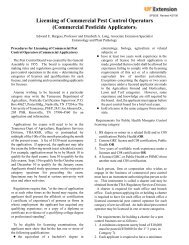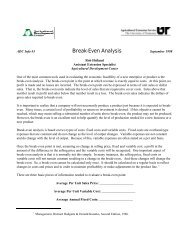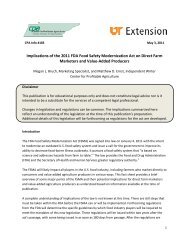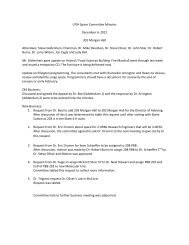Shipping Food Products with Dry Ice - The University of Tennessee ...
Shipping Food Products with Dry Ice - The University of Tennessee ...
Shipping Food Products with Dry Ice - The University of Tennessee ...
Create successful ePaper yourself
Turn your PDF publications into a flip-book with our unique Google optimized e-Paper software.
<strong>Dry</strong> <strong>Ice</strong> and Alternatives<br />
<strong>Dry</strong> ice is the solid form <strong>of</strong> carbon dioxide and is extremely cold (-109.5°F). However, carbon dioxide<br />
is commonly found in the earth’s atmosphere in its gaseous state. <strong>Dry</strong> ice will change directly from a<br />
solid to a gas at a rate <strong>of</strong> 5-10 pounds per 24 hours in a cooler. One <strong>of</strong> the most beneficial<br />
characteristics <strong>of</strong> dry ice is that it changes from liquid to gas during the thawing process, thus giving it<br />
the name <strong>of</strong> “dry ice.” This is advantageous in comparison to water ice since there is not a liquid state<br />
and will not saturate the package and product <strong>with</strong> water. <strong>The</strong> biggest drawback to using dry ice is the<br />
level <strong>of</strong> regulations that govern its use. Specifically, the rules are based on the hazardous nature <strong>of</strong> dry<br />
ice. <strong>The</strong> potential hazards <strong>of</strong> dry ice during transportation include explosion, suffocation and contact<br />
hazards. However, the risks <strong>with</strong> each <strong>of</strong> these can be addressed <strong>with</strong> proper planning and preparation.<br />
In his 2003 publication, Andy Glode, <strong>with</strong> the <strong>University</strong> <strong>of</strong> New Hampshire, outlined five basic<br />
requirements for shipping <strong>with</strong> dry ice. <strong>The</strong> requirements are presented below:<br />
1. Gas venting: packages must allow for release <strong>of</strong> carbon dioxide gas. <strong>Dry</strong> ice must never be<br />
sealed in a container <strong>with</strong> an airtight seal such as a jar <strong>with</strong> a threaded lid or a plastic cooler.<br />
2. Package integrity: a package containing dry ice must be <strong>of</strong> adequate strength for intended use. It<br />
must be strong enough to <strong>with</strong>stand the loading and unloading normally encountered in transport.<br />
It must also be constructed and closed in order to prevent any loss <strong>of</strong> contents that might be<br />
caused by vibration or by changes in temperature, humidity, or altitude.<br />
3. Package materials: do not use plastics that can be rendered brittle or permeable by the<br />
temperature <strong>of</strong> dry ice. This problem can be avoided by using commercially available packages<br />
intended to contain dry ice.<br />
4. It is possible that the carrier <strong>of</strong> the package will have specific labeling when using dry ice. It is<br />
important to consult the package carrier when you are shipping dry ice to determine their specific<br />
labeling requirements.<br />
5. Labeling: the outermost container must be labeled <strong>with</strong> a hazard class 9 label, UN 1845, and<br />
total weight <strong>of</strong> dry ice in kilograms. (See sample dry ice label that follows) <strong>The</strong> label should be<br />
affixed to a vertical side <strong>of</strong> the box (not the top or bottom) and oriented as in the figure below.<br />
(Glode, 2003)<br />
<strong>Dry</strong> <strong>Ice</strong> Label<br />
2

















